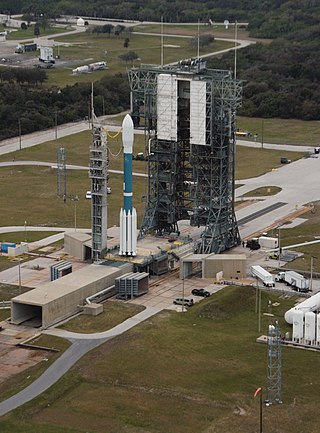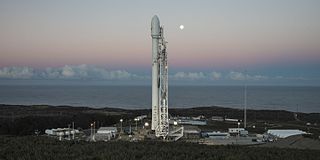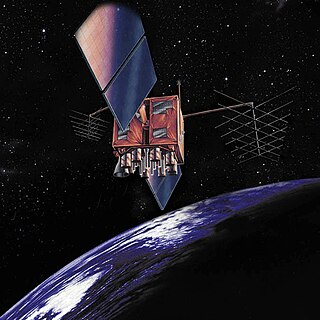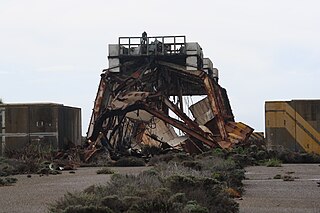
Vandenberg Space Force Base, previously Vandenberg Air Force Base, is a United States Space Force Base in Santa Barbara County, California. Established in 1941, Vandenberg Space Force Base is a space launch base, launching spacecraft from the Western Range, and also performs missile testing. The United States Space Force's Space Launch Delta 30 serves as the host delta for the base. In addition to its military space launch mission, Vandenberg Air Force Base also hosts space launches for civil and commercial space entities, such as NASA and SpaceX.

Cape Canaveral Space Force Station (CCSFS) is an installation of the United States Space Force's Space Launch Delta 45, located on Cape Canaveral in Brevard County, Florida.

Space Launch Complex 3 (SLC-3) is a launch site at Vandenberg Space Force Base that consists of two separate launch pads. SLC-3E (East) is was used by the Atlas V launch vehicle before it was decommissioned in August 2021 with the final launch taking place on November 10,2022 at 09:49, while SLC-3W (West) has been demolished.

Space Launch Complex 6 at Vandenberg Space Force Base in California is a launch pad and support area. The site was originally developed starting in 1966, but no launches occurred until 1995, as it was repurposed sequentially for three programs that were subsequently cancelled. Initially to be used for Titan IIIM rockets and the Manned Orbiting Laboratory, these were cancelled before construction of SLC-6 was complete. The complex was later rebuilt to serve as the west coast launch site for the Space Shuttle, but went unused due to budget, safety and political considerations. The pad was subsequently used for four Athena rocket launches before being modified to support the Delta IV launch vehicle family, which used the pad for ten launches from 2006 until 2022. The last Delta IV launched in September 2022, and SpaceX leased SLC-6 in 2023 to convert it to launch Falcon 9 and Falcon Heavy starting in 2025.

Space Launch Complex 37 (SLC-37), previously Launch Complex 37 (LC-37), is a launch complex on Cape Canaveral Space Force Station, Florida. Construction began in 1959 and the site was accepted by NASA to support the Saturn I program in 1963. The complex consists of two launch pads. LC-37A has never been used, but LC-37B launched uncrewed Saturn I flights and was modified and launched Saturn IB flights, including the first (uncrewed) test of the Apollo Lunar Module in space. It was deactivated in 1972. In 2001 it was modified as the launch site for Delta IV, a launch system operated by United Launch Alliance.

Space Launch Complex 17 (SLC-17), previously designated Launch Complex 17 (LC-17), was a launch site at Cape Canaveral Air Force Station (CCAFS), Florida used for Thor and Delta launch vehicles launches between 1958 and 2011.
Space Launch Complex 20 (SLC-20), previously designated Launch Complex 20 (LC-20), is a launch site at Cape Canaveral Space Force Station, Florida. SLC-20 is located at the northern terminus of ICBM Road, between Space Launch Complex 19 and Space Launch Complex 34.

Space Launch Complex 10, or Missile Launch Complex 10, is located on Vandenberg Space Force Base in Lompoc, California. It was built in 1958 to test ballistic missiles and developed into a space launching facility in 1963. Prior to 1966 Space Launch Complex 10 West was known as Vandenberg AFB Pad 75-2-6. It remains a rare pristine look at the electronics and facilities created in that era that helped the United States grow its space capabilities.

Space Launch Complex 4 (SLC-4) is a launch and landing site at Vandenberg Space Force Base, California, U.S. It has two pads, both of which are used by SpaceX for Falcon 9, one for launch operations, and other as Landing Zone 4 (LZ-4) for SpaceX landings.

The Delta 3000 series was an American expendable launch system which was used to conduct 38 orbital launches between 1975 and 1989. It was a member of the Delta family of rockets. Several variants existed, which were differentiated by a four digit numerical code.

Launch Complex 13 (LC-13) was a launch complex at Cape Canaveral Space Force Station, the third-most southerly of the original launch complexes known as Missile Row, lying between LC-12 and LC-14. In 2015, the LC-13 site was leased by SpaceX and was renovated for use as Landing Zone 1 and Landing Zone 2, the company's East Coast landing location for returning Falcon 9 and Falcon Heavy launch vehicle booster stages. It is leased by US Space Force to Phantom Space and Vaya Space who will operate this launch complex after the termination of SpaceX's lease in future.

GPS IIR-1 or GPS SVN-42 was the first Block IIR GPS satellite to be launched. It was to have been operated as part of the United States Air Force Global Positioning System. It was launched on 17 January 1997, and was destroyed 13 seconds into its flight due to a malfunction of the Delta II launch vehicle that was carrying it. It was estimated to have cost US$40 million, with its launch vehicle costing US$55 million. The satellite that was used for the GPS IIR-1 mission was the second production IIR satellite, SVN-42.

The 6555th Aerospace Test Group is an inactive United States Air Force unit. It was last assigned to the Eastern Space and Missile Center and stationed at Patrick Air Force Base, Florida. It was inactivated on 1 October 1990.

Space Launch Complex 1 (SLC-1) was a launch pad at Vandenberg Space Force Base in California, United States. SLC-1 consisted of two pads, SLC-1E and SLC-1W. Both sites were built in 1958 for the never activated 75th Strategic Missile Squadron for Thor Agena A launches. SLC-1E launch pad 75-3-5, SLC-1W launch pad 75-3-4. Both were upgraded to a Space Launch Complex (SLC) in 1966. Deactivated with phaseout of Thor-Agena. SLC-1E deactivated 1968, 45 launches; SLC-1W deactivated in 1971, 56 launches.

Firefly Aerospace is an American private aerospace firm based in Cedar Park, Texas, that develops launch vehicles for commercial launches to orbit. The company completed its $75 million Series A investment round in May 2021, which was led by DADA Holdings. The current company was formed when the assets of the former company Firefly Space Systems were acquired by EOS Launcher in March 2017, which was then renamed Firefly Aerospace. Firefly's purported purpose is to increase access to space, similar to other private spaceflight companies. Firefly Space shares its name with an American space-western drama TV series, Firefly.

Firefly Alpha is a two-stage orbital expendable launch vehicle developed by the American company Firefly Aerospace to compete in the commercial small satellite launch market. Alpha is intended to provide launch options for both full vehicle and rideshare customers.















